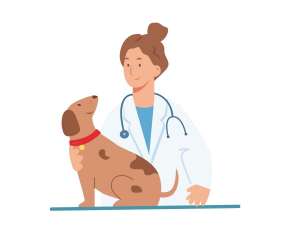





Have you ever considered giving antibiotics to your pet to treat skin infections? If yes, numerous antibiotics are available, and Cefpodoxime for dogs is one of them. But are there any side effects of this medication? How can you store it?
Today we asked our resident veterinarian Dr. Saba to discuss a bit more about how you can successfully use Cefpodoxime for dogs.
If you’d rather listen to this blog, just click play on the YouTube video below:
Cefpodoxime for Dogs at a Glance – 11 FAQs
Here are some of the most common questions I get as a vet about Cefpodoxime for dogs. If you need more information or have further questions about how you can use Cefpodoxime for dogs, leave a comment below and I’ll get back to you as soon as possible. But remember, if there’s an emergency, stop all use of any medications and contact your vet immediately.
If you’d like to know more about home medications that can help your pet, check out our approved vet list below.
| Dyne for Dogs: For Energy & Weight Gain | Omeprazole for Dogs: For Ulcers & Inflammation | Enrofloxacin for Dogs: For Bacterial Infections |
Cefpodoxime for Dogs: For Bacterial Infections | Sucralfate for Dogs: Chronic Upset Stomach | Cosequin for Dogs: For Joint Health |
| Ursodiol for Dogs: For Liver & Gallbladder | Trazodone for Dogs: For Anxiety & Aggression | Mometamax for Dogs: For Ear Infections |
| Credelio for Dogs: For Ticks & Fleas | Chlorpheniramine for Dogs: For Allergy-Related Conditions | Butorphanol for Dogs: For Painful Coughs |
| Dinovite for Dogs: For Irritating, Itchy Coat | Dasuquin for Dogs: For Joint Health | Meloxidyl for Dogs: For Pain & Inflammation |
| Glandex for Dogs: For Digestive Support | Rilexine for Dogs: For Bacterial Infections | Enalapril for Dogs: For Cardiac Conditions |
| Quercetin for Dogs: For Allergy & Inflammation | Carprovet for Dogs: For Pain & Inflammation | Pimobendan for Dogs: For Congestive Heart Failure |
| Simplicef for Dogs: For Bacterial Infections | Clindamycin for Dogs: For Bacterial Infections |
If you’re considering giving your pet human medication, it’s a good idea to stay in close contact with your vet. At Avenue Dogs, we’re committed to providing vet-approved advice for pet owners. However, the advice of your personal vet is no replacement for advice from your online info or otherwise. Please seek immediate care for emergency cases.
Q: What is cefpodoxime for dogs?
A: Cefpodoxime is an antibiotic medication that is commonly used to treat bacterial infections in dogs. It belongs to the class of antibiotics known as third-generation cephalosporins.
Q: What types of infections can cefpodoxime treat in dogs?
A: Cefpodoxime is effective in treating a wide range of bacterial infections in dogs, including; wound or surgical skin infections, urinary tract infections, respiratory infections, and ear infections.
Q: How is cefpodoxime administered to dogs?
A: Cefpodoxime is typically administered orally in the form of chewable tablets as well as liquid form. The dosage and duration of treatment depend on the type and severity of the infection.
Q: What are the possible side effects of cefpodoxime for dogs?
A: Common side effects of cefpodoxime in dogs may include diarrhea, vomiting, and loss of appetite. In rare cases, it may cause more severe side effects, such as an allergic reaction. If you suspect your pooch is having a negative reaction to cefpodoxime (or any other medication) seek immediate medical attention from your vet.
Q: Can cefpodoxime be given to pregnant or nursing dogs?
A: Typically, no. Cefpodoxime should be used with caution in pregnant or nursing dogs, as it may pass through the placenta or milk and affect the developing fetus or puppies. It is important to consult with a veterinarian before using cefpodoxime in these cases.
Q: Is cefpodoxime safe for all dogs?
A: Cefpodoxime is generally safe for most dogs when used as directed by a veterinarian. However, it should not be used in dogs with a known hypersensitivity to cephalosporins or other beta-lactam antibiotics.
Q: Can cefpodoxime be given with other medications?
A: Cefpodoxime may interact with other medications, such as antacids or probiotics, which may reduce its effectiveness. It is important to inform the veterinarian of any other medications the dog is taking before starting cefpodoxime treatment.
Q: How long does it take for cefpodoxime for dogs to start working?
A: Like all antibiotics, the onset for cefpodoxime can vary depending on the type and severity of the infection. In general, it may take a few days to see improvement in the dog’s symptoms.
Q: Can cefpodoxime be used to treat viral infections in dogs?
A: No, cefpodoxime is only effective against bacterial infections and cannot be used to treat viral infections in dogs.
Q: How should cefpodoxime be stored?
A: Cefpodoxime should be stored at room temperature and kept out of reach of children and pets. The medication should be kept in its original container and away from moisture and light.
Q: Does cefpodoxime make dogs sleepy?
A: Generally, a normal dose of Cefpodoxime doesn’t make your dog sleepy. However, an excessive amount can result in side effects like diarrhea, vomiting, and lethargy. If you find your pet sleepy after giving him a dose, reduce the amount of the dose. Or it’s better to consult your vet without wasting any time.
Looking for more detailed info on Cefpodoxime for dogs? Keep reading…
Cefpodoxime for Dogs – Safely Treat Bacterial-Based Infections
Cefpodoxime, a third-generation cephalosporin antibiotic, treats skin infections in canines and is an FDA-approved drug. This drug is a broad-spectrum antibiotic; therefore, it helps treat various infections.
It is effective against numerous bacteria that cause respiratory and urinary tract infections. These bacteria include E.coli, Staphylococcus, Streptococcus canis, and many more.



Cefpodoxime is an off-label medication recommended for urinary tract infections in cats and dogs. Numerous medicines are used as off-label in veterinary medicine. However, it’s better to follow your vet’s advice carefully.
How Cefpodoxime for Dogs Works?
Cefpodoxime belongs to third-generation cephalosporins. That’s why it is effective over first and second-generation antibiotics of the same class.
The drug interferes with the cell walls of susceptible bacteria. In short, Cefpodoxime inhibits the production of proteins crucial for developing the bacterial cell wall. Cefpodoxime for dogs is a good option for surgical and wound infections that don’t respond to other medications.



It is important to note that this medication doesn’t kill all kinds of bacteria. For example, you might find it ineffective against fungi, viruses, and parasites.
Misuse of antibiotics, including Cefpodoxime, results in the development of antibiotic-resistant bacteria. Therefore, use such antibiotics only if your veterinarian prescribes them.
How Is Cefpodoxime for Dogs Given?
Cefpodoxime is available in two forms, tablets and as a liquid oral suspension. It’s essential to shake the liquid form carefully before each use.
The drug can be given with or without food. But if your pet reacts to having a dose on an empty stomach, try administering next time with food. In the case of any adverse reaction, contact your vet immediately.



Cefpodoxime for dogs starts to become effective in two hours. Cefpodoxime is a short-acting drug that typically wears off within 24 hours. Try to follow dosages your vet has prescribed as closely as possible, even if your pup starts feeling better. Please don’t stop giving a dose without discussing it with your vet.
What Is Cefpodoxime For Dogs Used For?
This antibiotic helps treat various urinary tract infections. These infections often lead to frequent urination, difficulty in urinating, and lethargy. If your dog shows any of these symptoms, take your pet to a vet immediately.
Also, outdoor dogs mostly get infected wounds because of any injury. Such infections can result in swelling, redness, and discharge from the wound; therefore, Cefpodoxime is an effective solution against these bacterial-based infections.



In addition, Cefpodoxime is used in treating Pneumonia caused by bacteria. Pneumonia commonly affects puppies and elderly dogs. Symptoms in this situation include:
- Fever
- Cough
- Rapid Breathing
A vet can give you an accurate assessment of the best route to take for your dogs individual needs.
What Are The Side Effects Of Cefpodoxime For Dogs
Cefpodoxime shows a few side effects in canines, including:
- Diarrhea
- Decreased appetite
- Vomiting
- Lethargy
- Shortness of breath
If these side effects lost longer or get severe, it’s time to call a vet. Besides, hypersensitivity reactions can result in skin rash (particularly in the ears), pale gum, hives, difficulty breathing, and swelling of the face.
Are There Any Risk Factors of Cefpodoxime for Dogs?
This medication is not effective for pets that are allergic to it or its related class of antibiotics. Cefpodoxime can be used in pregnant dogs, but you should handle it carefully in the case of nursing dogs.



What If I Miss Giving A Dose to My Dog?
The typical dose of Cefpodoxime for dogs is 2.3 to 4.5 milligrams per pound of the body’s weight approximately every 24 hours. If you have a missing dose, please share it with your pet by the time you remember.
But if the time for the next dose is too short (within a few hours), give it at the next regularly scheduled time instead. After that, continue giving a regular amount to your pet. Avoid giving your pet extra doses or two doses at a time.
Are There Any Drug Interactions That A Pet Owner Should Know?
Interaction of Cefpodoxime with other drugs reduces its absorption. Therefore, this drug might interact with other medications. So, let your vet know if your pet is already taking any vitamins or supplements. In the case of diabetic dogs, Cefpodoxime might interact with urine glucose tests and give false-positive results.
Is There Any Monitoring That This Medication Needs?
Besides monitoring your dog’s response to a drug, no special monitoring is essential for Cefpodoxime. However, your vet can suggest routine testing according to your pet’s condition.



How to Store Cefpodoxime for Dogs?
It’s essential to store these Cefpodoxime tablets in an air-tight container away from the light. You should keep this medication between 68°F and 77°F (20-25℃) temperatures.
However, the suitable temperature for liquid suspensions is 35°F and 45°F (2-8℃). Also, unused liquid forms should be discarded after 14 days.
What to Do In Case of Emergency?
In the case of overdosing on Cefpodoxime, your pet might suffer from vomiting, diarrhea, lethargy, and loss of appetite. Unfortunately, overdosing might cause severe consequences in some cases.



If your pet shows any adverse reaction, contact your vet without delay. If a vet is not available, seek guidance from an emergency facility.
Cefpodoxime for Dogs Reviews
For the most part, pup-parents seem to be happy with the effects of Cefpodoxime for dogs. Let’s take a look at some of their reviews…

















Cefpodoxime for Dogs – Final Thoughts from a Vet
Like any medication, Cefpodoxime for dogs should be used with caution. Seek medical advice if you think your pet may have a condition that needs treated with antibiotics such as Cefpodoxime. In most cases, your veterinarian will have no problem prescribing Cefpodoxime for dogs, especially if they’ve shown no adverse reactions to similar drugs in the past.






Dr Saba Afzal is a clinical veterinarian and a professional content writer. I am determined to disseminate ideas worth spreading to pet owners everywhere around the world. As an experienced veterinarian, I am dedicated to delivering accurate and updated knowledge to pet owners
I have more than five years of experience in content writing on different online platforms, including Fiverr, Upwork, and Guru. My expertise is in Microbiology, Biotechnology, Pets Animal Management and handling, and training. You will find my content truly fascinating, unique, and compatible with the world’s standards. I always write original content without any plagiarism and taking care of any grammatical errors.
I will be happy to address your queries and comments. Contact me here

5 Comments